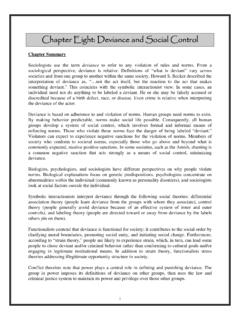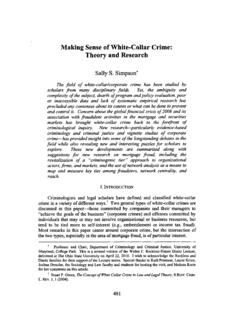Transcription of Chapter Eight: Deviance and Social Control
1 1 Chapter Eight: Deviance and Social Control Chapter Summary Sociologists use the term Deviance to refer to any violation of rules and norms. From a sociological perspective, Deviance is relative. Definitions of what is deviant vary across societies and from one group to another within the same society. Howard S. Becker described the interpretation of Deviance as, ..not the act itself, but the reaction to the act that makes something deviant. This coincides with the symbolic interactionist view. In some cases, an individual need not do anything to be labeled a deviant. He or she may be falsely accused or discredited because of a birth defect, race, or disease. Even crime is relative when interpreting the Deviance of the actor. Deviance is based on adherence to and violation of norms.
2 Human groups need norms to exist. By making behavior predictable, norms make Social life possible. Consequently, all human groups develop a system of Social Control , which involves formal and informal means of enforcing norms. Those who violate these norms face the danger of being labeled deviant. Violators can expect to experience negative sanctions for the violation of norms. Members of society who conform to societal norms, especially those who go above and beyond what is commonly expected, receive positive sanctions. In some societies, such as the Amish, shaming is a common negative sanction that acts strongly as a means of Social Control , minimizing Deviance . Biologists, psychologists, and sociologists have different perspectives on why people violate norms. Biological explanations focus on genetic predispositions, psychologists concentrate on abnormalities within the individual (commonly known as personality disorders), and sociologists look at Social factors outside the individual.
3 Symbolic interactionists interpret Deviance through the following Social theories: differential association theory (people learn Deviance from the groups with whom they associate), Control theory (people generally avoid Deviance because of an effective system of inner and outer controls), and labeling theory (people are directed toward or away from Deviance by the labels others pin on them). Functionalists contend that Deviance is functional for society; it contributes to the Social order by clarifying moral boundaries, promoting Social unity, and initiating Social change. Furthermore, according to strain theory, people are likely to experience strain, which, in turn, can lead some people to chose deviant and/or criminal behavior rather than conforming to cultural goals and/or engaging in legitimate institutional means.
4 In addition to strain theory, functionalists stress theories addressing illegitimate opportunity structure in society. Conflict theorists note that power plays a central role in defining and punishing Deviance . The group in power imposes its definitions of Deviance on other groups, then uses the law and criminal justice system to maintain its power and privilege over those other groups. 2 Reactions to Deviance in the United States include everything from mild sanctions to capital punishment. Since the 1980s, the United States has adopted a get tough policy on crime that has imprisoned millions of people. Prisoners are generally much younger than the average American, nearly 94 percent male, and disproportionately African American. Because crime statistics are produced within a specific Social and political context for particular purposes, they must be interpreted with caution.
5 Power plays a central role in determining which behaviors are defined as crimes, as well as in how actively criminal behaviors are prosecuted and/or punished. For example, although street crime is given the greatest attention by the media because of the violence associated with it, white - collar crime actually costs the American taxpayers more. Even cases of gross negligence that cause death are funneled into administrative hearings that, at times, result in little more than a fine for the corporation. The definition of crime is subject to change, however, and the ways various acts are treated by society changes with shifts in power and public priority. Since the early twentieth century, there has been a growing tendency toward the medicalization of Deviance , viewing Deviance , including crime , as mental illness. Thomas Szasz offers another perspective, claiming that mental illnesses are neither mental nor illness.
6 Rather, they are problem behaviors that are related to people s particular experiences in life. For example, disruptive and unruly behaviors that disrespect authority and deviate from Social norms are now a treatable mental illness recognized as Attention-Deficit disorder (ADD). As Deviance is inevitable, the larger issues include: finding ways to protect people from those forms of Deviance that harm themselves and/or others, tolerating deviant behaviors that are not harmful, and developing systems of fairer treatment for deviants. 3 Chapter Outline I. What is Deviance ? A. Sociologists use the term Deviance to refer to a violation of norms. 1. According to sociologist Howard S. Becker, it is not the act itself that makes an action deviant, but rather how society reacts to it. 2. Because different groups have different norms, what is deviant to some is not deviant to others.
7 This is true even for criminal Deviance , the violation of rules that have been written into law. 3. Deviants are people who violate rules, whether the infraction is minor (jaywalking) or serious (murder). When sociologists study Deviance they are nonjudgmental; they are not judging whether the behavior is good or bad, just that it is viewed negatively by people within the Social group. To sociologists, all people are deviants because everyone violates rules from time to time. 4. Erving Goffman used stigma to refer to attributes that discredit one's claim to a normal identity; a stigma ( , blindness, mental handicaps, facial birthmarks) defines a person's master status, superceding all other statuses the person occupies. B. Norms make Social life possible by making behavior predictable. Without norms, Social chaos would exist.
8 The reason Deviance is seen as threatening is because it undermines predictability. Thus, Social Control (the formal and informal means of enforcing norms) is necessary for Social life. C. When a norm is violated, sanctions are imposed. 1. Sanctions can be either negative or positive. 2. Negative sanctions, which reflect disapproval of a particular behavior, range from frowns and gossip for breaking a folkway to imprisonment and capital punishment for breaking a more. 3. Positive sanctions, from smiles to formal awards, are used to reward conformity. 4. Most sanctions are informal. D. Shaming is another sanction. It is particularly effective when used by members of a primary group or in a small community. 1. Shaming can be the centerpiece of public ritual, marking the violator as deviant for the entire world to see.
9 2. Harold Garfinkel used the term degradation ceremony to describe formal attempts to label someone as an outsider. E. Comparisons can be made between biological, psychological, and sociological explanations of Deviance . 1. Psychologists and sociobiologists explain Deviance by looking within individuals; sociologists look outside the individual. 2. Biological explanations focus on genetic predisposition, including factors such as intelligence; the XYY theory (an extra Y chromosome in men leads to crime ); or body type (squarish, muscular persons more likely to commit street crimes). 3. Psychological explanations focus on personality disorders ( , bad toilet training, suffocating mothers, and so on). Yet these do not necessarily result in the presence or absence of specific forms of Deviance in a person.
10 4 4. Sociological explanations search outside the individual: crime is a violation of norms written into law, and each society has its own laws against certain types of behavior, but Social influences such as socialization, subcultural group memberships, or Social class (people's relative standing in terms of education, occupation, income and wealth) may recruit some people to break norms. II. The Symbolic Interactionist Perspective A. Differential association is Edwin Sutherland's term to indicate that those who associate with groups oriented toward deviant activities learn an excess of definitions of Deviance and thus are more likely to engage in deviant activities. 1. The key to differential association is the learning of ideas and attitudes favorable to following the law or breaking it.

















